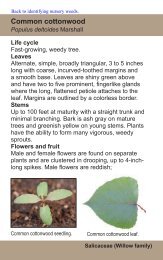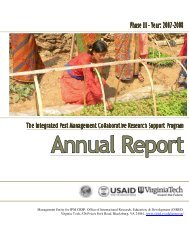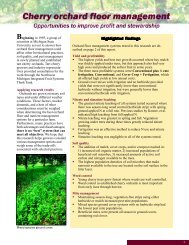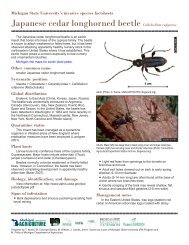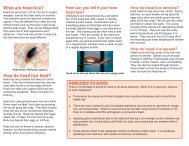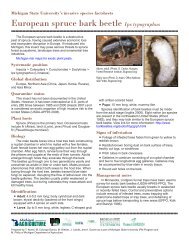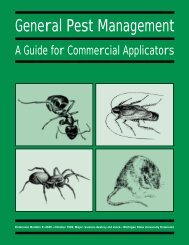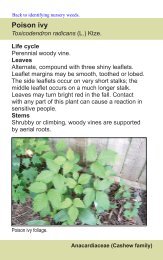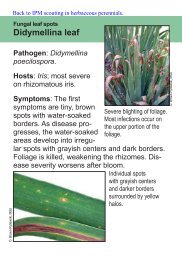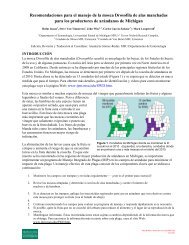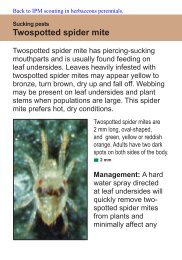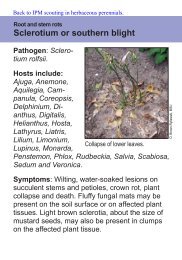Whole Manual - Michigan State University: Integrated Pest ...
Whole Manual - Michigan State University: Integrated Pest ...
Whole Manual - Michigan State University: Integrated Pest ...
Create successful ePaper yourself
Turn your PDF publications into a flip-book with our unique Google optimized e-Paper software.
accurately written records of field locations, field conditions,<br />
previous pest infestations, and control measures.<br />
With this information, you can determine what control<br />
measures are appropriate.<br />
control measures are expensive or the vale of the crop is<br />
low, the economic threshold is usually high. High control<br />
costs means it takes more crop loss to justify the control<br />
action.<br />
Economic thresholds are often referred to as action<br />
thresholds. When the pest population reaches the threshold,<br />
action is taken to reduce the population. For insects,<br />
an economic or action threshold is typically expressed as<br />
the number of insects per plant or per leaf or the amount<br />
of crop damage.<br />
Remember the following basic principles when<br />
scouting:<br />
■ Take samples from several areas of the field.<br />
■ Select sample sites at random unless field conditions<br />
suggest uneven pest distribution.<br />
■ DO NOT sample in border rows or field edges<br />
unless indicated to do so for a particular pest.<br />
Insect pests can be monitored in several ways. The<br />
most common methods are actually counting the number<br />
of insects present or estimating the amount of insect damage.<br />
Insect counts usually are expressed as the number of<br />
insects per plant or plant part (e.g., number of insects per<br />
leaf). Insect crop damage is often expressed as percentage<br />
of the plant damaged (e.g., percent leaf defoliation).<br />
Other insect monitoring methods include collecting<br />
insects with a sweep net, shaking crop foliage and counting<br />
dislodged insects, and trapping insects. Disease monitoring<br />
can be accomplished through scouting fields<br />
weekly and examining foliage for early disease symptoms.<br />
Also, monitoring the weather can indicate when<br />
conditions are favorable for disease development. <strong>Pest</strong><br />
alerts and newsletters provided by MSUE county agents<br />
and other MSU personnel indicate pest pressure and outbreaks<br />
in the region and state.<br />
ECONOMIC THRESHOLDS<br />
An economic threshold is defined as the pest density<br />
at which action must be taken to prevent the pest population<br />
from increasing and causing economic damage.<br />
Economic thresholds are constantly changing and vary<br />
between fields, crop varieties, and crop growth stages.<br />
Economic thresholds are a function of crop value and cost<br />
of control. In general, a high-value crop will have a lower<br />
economic threshold; less pest damage will be accepted<br />
and control measures must be implemented sooner. If the<br />
CONTROL STRATEGIES<br />
CULTURAL CONTROL<br />
Cultural control uses farming practices to reduce pest<br />
populations by implementing a practice such as tillage or<br />
crop rotation at the correct time to kill or reduce pest<br />
numbers or slow pest development. Like all other control<br />
strategies, cultural control requires an understanding of<br />
the pest and the crop. Cultural control measures are usually<br />
applied at the weakest stage of the pest’s life cycle<br />
and are generally preventive actions rather than curative<br />
actions.<br />
Cultural control methods work in three ways:<br />
1. Prevent the pest from colonizing the crop or<br />
commodity.<br />
2. Create adverse conditions that reduce survival of<br />
the pest.<br />
3. Reduce the impact of pest injury.<br />
PREVENTING COLONIZATION<br />
Control measures that prevent colonization physically<br />
exclude the pest, reduce pest populations, prevent the<br />
pest from finding the crop, or disrupt the timing between<br />
the pest and the crop.<br />
A. Trap crop—planting a small area with a preferred<br />
host to attract the pest away from the crop. Once in the<br />
trap crop, the pest can be destroyed or controlled. For<br />
example, trap crops can help control striped cucumber<br />
beetles. The beetles are attracted to the oldest, most<br />
mature crop in an area. An early planting of pumpkins or<br />
cucumbers attracts early-season striped cucumber beetles,<br />
concentrating the population and preventing movement<br />
to the primary crop.<br />
B. Physical barriers—separating a pest and host with<br />
an object such as a wall or a ditch to stop the pest from<br />
infesting—for example, covering the soil with black plastic<br />
to control weeds.<br />
C. Crop rotation—a cycle in which different crops are<br />
planted in a field every year; the longer the rotation<br />
between crops susceptible to the same pests, the better<br />
the pest control. A crop rotation system helps control<br />
pests such as tomato diseases. Tomatoes should not be<br />
rotated with peppers, eggplant, or any cucurbits (pumpkins,<br />
zucchini, winter squash, cucumber, watermelon or<br />
muskmelon).<br />
D. Delayed planting (timing)—changing the planting<br />
date so that the host is not available when the pest is<br />
Chapter 1<br />
2<br />
Vegetable Crop <strong>Pest</strong> Management



